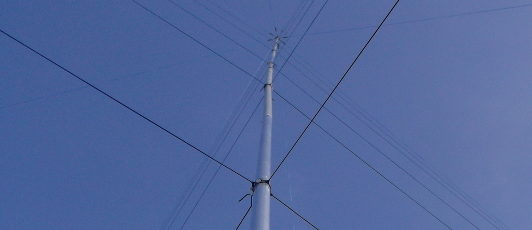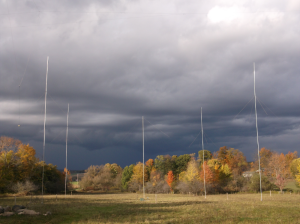Details on this November’s 630M Crossband Night can be found on VE7SL’s blog:
http://ve7sl.blogspot.ca/2016/10/novembers-630m-activity-cw-crossband.html
Usually about the second or third week of November I make my bi-annual rounds repairing the receive antennas in the back woodlot, mostly damaged by tree related incidents. While I’ve performed initial inspections of some antennas, I haven’t gotten around to actually repairing anything yet. The 630M Eight Circle has a number of issues that are affecting its optimal performance, though it still exhibits reasonably good directivity. I also discovered that one beverage element in my 160M west array had snapped. I was not optimistic about my chances of hearing any of the VE7 stations that would be QRV on 630M.
Mitch, VE3OT, was worked early in the evening with his usual strong signals. He is only located across Lake Erie from here, so always has a potent presence.
What transpired later in the evening was entirely unexpected. Propagation seemed “long” much earlier than usual, and at least at this QTH, QRN was very low. Just prior to 0500z, I tuned to VE7SL’s QRG and was surprised at how well Steve’s signals were coming in, some of the best I had remembered ever hearing from him on 630M. One by one, over the next hour, each of the three remaining VE7s were worked, catching them on individual QSB peaks. In past crossband activity nights, I have worked Steve, VE7SL, but this event marked the first time I was able to work all four active VE7 (BC) stations. Below are audio clips of each:
VE7SL (QSO @0501z):
VE7CNF (QSO @0522z):
VE7BDQ (QSO @0543z):
VA7MM (QSO @0551z):
This was a truly remarkable evening! Receive equipment included my K3 in diversity with the Eight circle array (aimed west) feeding one channel and the west or northwest 160M beverage arrays in the other channel. Various filtering was tried, but ultimately, the K3’s APF helped pull all but VE7SL’s signals out of the noise. This was interesting, as I had not found APF to be that useful in the past, but certainly couldn’t dispute the enhancements it provided this time. I believe very low ambient band noise may have contributed to the APF’s effectiveness.
I’m already looking forward to the next crossband event, but even more so, when US Amateurs are allocated 630M!


